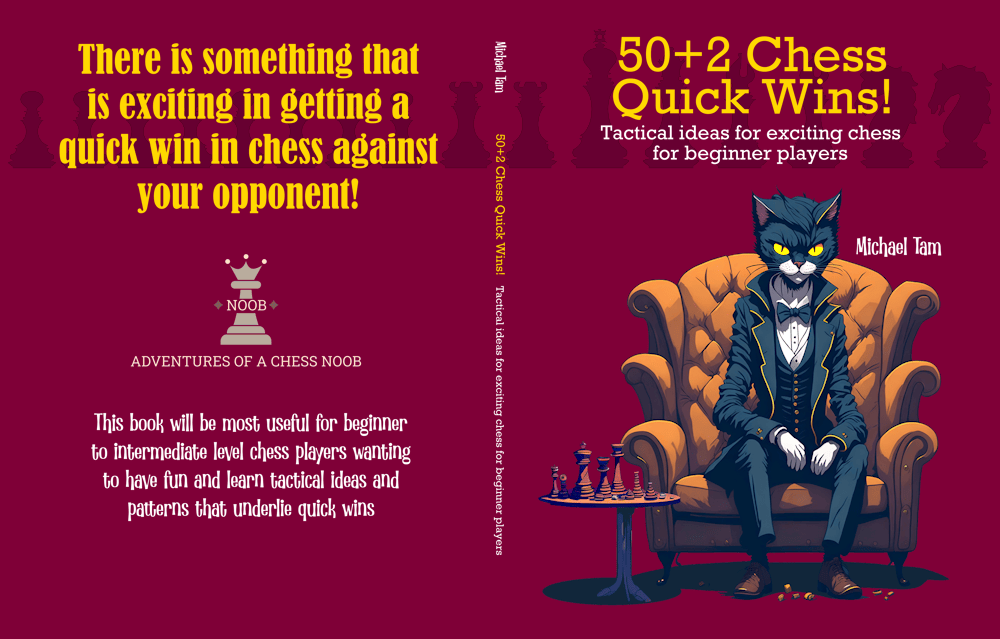
Smith-Morra Gambit x 2 | TRIPLE brilliant and PIRATE chess!
#smith-morra #sicilian #brilliant #chessromance
A question that I’ve been asked frequently by beginner players is, “what opening should I learn to play?”, often in the context that they want to branch out from playing the Italian Game. Now, clearly there are many named openings which are excellent – they are solid and a great foundation for improvement. Those of you who follow my channel and blog will know that I’m a great proponent of the idea that we must keep chess fun, especially at the casual level. So, my view is that part of the decision-making in developing your opening repertoire must include a reflection about your own character – what sort of chess do you like to play?
If you haven’t tried out the chess.com Chess Personality Test, give it a go as a bit of fun! I’m apparently a Chess Assassin!

![]()
For me, I love openings that give the opportunity for brash, swashbuckling tactics! And against the very solid Sicilian Defense, my favourite response is the Smith-Morra Gambit with the white pieces. And it’s not even dodgy! With the Sicilian Defense (1. e4 c5), Black immediately equalises the win ratio according to the Lichess community database: 48% vs 48%, but at the point of the Smith-Morra Gambit, Accepted (2. d4 cxd4 3. c3 dxc3), White regains the win advantage at 52% vs Black 45%.

1. e4 c5 2. d4 cxd4 3. c3 dxc3
![]()
A historical digression:
The very first game of the Sicilian Defense: Smith-Morra Gambit Accepted that I could find in the massive LumbrasGigabase was played by Lionel Kieseritzky (1806-1853), one of the best chess masters from the Romantic Age of chess. He was born in the Baltic part of the then Russian Empire, now part of modern-day Estonia. In 1840, he relocated to Paris and was one of the leading French masters in the famous Café de la Régence, along with luminaries such as Bourdonnais, Saint-Amant, and Boncourt. We have Kieseritzsky to thank for not only losing the casual game against Anderssen’s “The Immortal Game”, but recording it, and publishing it while he was the editor of La Regence.
Check out this amazing game (Kieseritzky — Vitzthrum, 1846, Paris, France) where we see Kieseritzky’s romantic flair with the Smith-Morra! He sacrifices… the ROOOKK!... on turn 14 as a trap and crushes poor Vitzthrum thereafter!
Curiously, as I doing some research for this article, I noticed a name that I didn’t recognise playing the opening very frequently – GM Milan Matulović (1935-2013) from Serbia/the former Yugoslavia. In fact, The Oxford Companion to Chess (2nd Ed) which I use extensively, has an entry for the “Matulović Gambit” as a synonym for the Smith-Morra Gambit!

![]()
He was a very strong player, twice Yugloslav Chess Champion (1965, and ’67), and at his peak, was able to competitively compete with the world’s best. Indeed, in 1958, he played a four-game training match with Bobby Fischer, where he won once, drew once, and lost twice. Not bad! So, why do we know so little about him? It is perhaps a salutary message on why one must hold themselves with integrity. Regardless of his many accomplishments, Matulović’s legacy is tainted by reports of repeated instances of poor sportsmanship, and unethical behaviour. The Oxford Companion outright states that he cheated in 1967, and that he wasn't invited to many tournaments due to antisocial behaviour! And from Wikipedia:
Perhaps Matulović’s most notorious transgression was against István Bilek at the Sousse Interzonal in 1967. He played a losing move but then took it back after saying “j’adoube” (“I adjust” – spoken before adjusting pieces on their square). His opponent complained to the arbiter but the move was allowed to stand. This incident earned Matulović the nickname “J'adoubovic”. This reportedly happened several times, including in a game against Bobby Fischer.
In an alternate timeline, what might have become known as the Matulović Gambit rather than the Smith-Morra is demonstrated by the smashing 13-move victory in (Matulović — Vincent, 1954, Yugoslavia).
![]()
I recently played a couple of games of the Smith-Morra Gambit Accepted. The first was against a Random Noob and in fact, was what inspired me to start the new series on my channel – Noob vs Noob UNPLUGGED! The second game was an exciting swashbuckling 10+5 game of pirate chess (🦜🤪👍🏴☠️♟️), where I blunder a piece in the opening, and then turn it around for glorious victory! 🤩
![]()
Game 1: The Hidden Triple Sacrifice Line!
Game 1 transposes down the well-trodden path of the Paulsen Formation in the Smith-Morra Gambit. Black is slightly better evaluation-wise and up a pawn, but White is slightly more likely to win.

![]()
My opponent plays well, and I play largely fine too, and the evaluation stays mostly equal. The fascinating thing on analysis is discovering things that you didn’t see in game. On turn 17, I played a tricky move (17. Nh4) which Stockfish didn’t like but was critical to my eventual winning attack. However, at this point in the game, the engine identifies an absolutely ridiculous triple sacrifice winning line! Check out the video and the PGN below – it starts with (17. Nxe5!!) knight sacrifice, followed by (18. Rxc6!!) rook sacrifice, and then a few moves later, we sacrifice the OTHER ROOK (21. Rxd7+!!). It looks like utter madness, but if Black takes that last rook, then White wins with forced checkmate [+M4] down six points of material! WOW! 😍 It’s an incredible romantic line that I wish I saw in game!
Instead, Black plays an aggressive forward knight move (17… Nd4??) – setting up an absolute fork on my king and rook. In doing so though, they hang their own rook on a8, which critically weakens their back rank! Black’s king attempts to run, but the knight I moved earlier to h4 strikes, forcing the king back onto the back rank (20… Ke7 21. Nf5+ Ke8). Checkmate-in-two – it’s never too late to hang back rank mate!
Game 1: https://www.chess.com/analysis/library/5ErFKcHvW2
![]()
Game 2: Reversing a lost position with pirate chess for the win!
Game 2 was a Lichess game of 10+5 rapid, and I was a bit tipsy having had a few drinks with dinner. Black played an interested fianchetto line (5… g6) and I decided to be provocative and played (6. Qf3?!), threatening a Scholar’s Mate. This is not a good move as it is quite easy for Black to block that attack, which they did with (6… e6).
A couple of moves later, a pretty much blunder a piece after (7… Ne5). Black had a fork of my bishop and queen (don’t bring out your queen early!) and I missed a tricky response (8. Qe3 Nxc4 9. Qd4) which counter-forks Black’s knight and rook – essentially trading the light square bishop for Black’s knight.
Instead, having lost a minor piece with not much compensation [-2.7], this woke me up a bit and I was determined to get a reversal! That is, pirate chess, aggressive swashbuckling play to at least wrangle a draw, but a win if possible.
We manoeuvre a bit and in the early middlegame, I find an opportunity! I manage to trap Black’s dark square bishop with (17. g3), so at least I should be able to at least return to numerical piece equality. However, Black decided to double-down with the attack on my kingside with (17… Bh3), threatening my f1-rook. Here, the sensible part of me knew that I could just move the rook, but I didn’t like the fact that Black had their light square bishop on h3 near my king – a position that I couldn’t easily touch.
So, I decided to trade my rook for their bishop! After (18. gxh4!? Bxf1 19. Kxf1), I’d captured both of Black’s bishop for the cost of my rook. Stockfish thinks I’m mad, but it took away an immediate risk.
My logic was that I was in a losing position, but I saw a possible counterattack on Black’s king’s position, especially along the dark squares. Black infiltrated with their queen and bishop – a very powerful combination, a winning combination! However, my intuition was that I could defend the position just enough to successful launch my tactic. And I was right!
On turn 28, Black couldn’t resist gobbling up my material, capturing my hanging rook with (28… Qxb1??), but it’s a blunder! I get my reversal and the evaluation shifts from [-8.5 to 0.00]! What Black didn’t appreciate with my last few moves moving my queen to attack their king was that I was now close enough to force a draw. Against (29. Qxe5+), which skewers Black’s king along the long dark square diagonal against their rook, Black had only three legal moves. The first is to block the check with their f-pawn (29… f6), which is what they played. Perhaps better was (29… Kg8), but after (30. Bb2) forming a battery along the diagonal, Black is in a zugzwang! The third move (29… Kf8) transposes to the same position as Kg8 after (30. Ba3+ Kg8 31. Bb2).
In the game, after (29… f6 30 Qe7+!), Black’s king has only two legal moves. If Kg8, then I can force a threefold repetition: my queen shuffles between e6 and e7, and the king dances between g7 and g8.
Black attempted the dance for one repetition, and then tried the other legal move (32… Kh6??). However, what seems like an escape door was a path to the king’s doom [+M4], but this wasn’t easy to see as the first step was… (33. Ng4+), double-check! Three knight moves with check corral Black’s king into the killing square and then (36. Qg5#), the queen strikes the killing blow! Glorious victory, good game, GG!
Game 2: https://www.chess.com/analysis/library/4XgddXbeW2
![]()
The big takeaway from these games is that if you love tactical chess, then the Smith-Morra Gambit is a fantastic way of responding to the Sicilian Defense!



